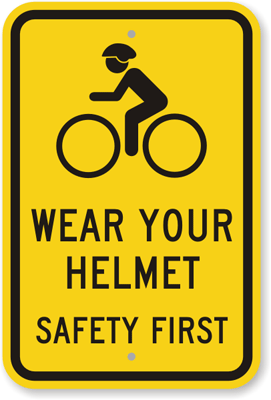Written By: John McLeish and Courtney Stewart, Summer Student
Cycling, rollerblading, and skateboarding are all great ways to enjoy Ontario’s beautiful summer weather, and are all activities for which you should always wear a helmet. Since summer is almost officially here and June is Brain Injury Awareness Month, this is a great time to remind everyone of the importance of bicycle helmets and how to properly fit and use them.
In Ontario, anyone under the age of 18 is required by law to wear an approved bicycle helmet when travelling on the roadway. Parents of children under 16 are legally responsible for ensuring their children wear helmets.
Bicycle helmets are specifically designed to protect the skull and brain during a fall or collision. Research has shown that helmets, when worn correctly, can be extremely effective in preventing head injuries. Helmets can reduce the risk of brain injury following collisions or falls by over 85%.
To prevent serious injury, anyone who cycles, skateboards or rollerblades, regardless of their age, should wear a helmet.

It is important to purchase the right helmet and make sure it fits properly. Buying the wrong helmet or not properly fitting your helmet will not give you the protection you need in the event of a fall or collision. Make sure to strap on your helmet properly and ensure that it fits each and every time.
When purchasing a helmet, check inside the helmet for stickers from one or more of the following organizations approved by the Ontario government:
- Canadian Standard Association: CAN/CSA D113.2-M89
- Snell Memorial Foundation: Snell B90, Snell B95, Snell B90S, or Snell N94
- American National Standard Institute: ANSI Z90.4-1984
- ASTM International: ASTMF1447-94
- British Standards Institute: BS6863:1989
- Standards Association of Australia: AS2063.2-1990
- United States Consumer Product Safety Commission (CPSC) 16 CFR Part 1203
Once you have purchased your helmet, follow these steps to ensure that your helmet fits properly and is providing you with the best protection possible.
- Read, follow and save the instructions that come with your helmet.
- Make sure the helmet fits snuggly – it should be tight enough to move your skin if you wiggle your helmet and the helmet should not move by itself if you shake your head.
- Once you ensure that the helmet fits snuggly follow the “2-V-1” rule to ensure that the helmet is sitting on your head correctly and the straps are properly secured:
- The front edge of your helmet should be two fingers above your eyebrows.
- The straps should form a “V” around your ears.
- One finger should fit between your chin and the chinstrap.
Helmets do not last forever. You should replace your helmet if:
- You have experienced a collision or fall
- the helmet is cracked
- the foam is falling apart
- the straps come loose while you are wearing the helmet
- the helmet is five years old
Also remember to check regularly that a child has not outgrown their helmet by following the steps above and ensuring the helmet is not too tight.
Taking a few moments to follow these steps can help reduce the chance of serious brain injury to you or your child. If you or a loved one is injured following a cycling, rollerblading or skateboarding fall or collision, contact one of the experienced critical injury lawyers at McLeish Orlando LLP for a free consultation.






